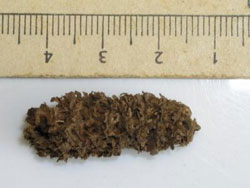Ancient popcorn discovered in Peru

Some of the oldest known corn cobs, husks, stalks and tassels, dating from 6,700 to 3,000 years ago were discovered at Paredones and Huaca Prieta, two mound sites on Peru’s arid northern coast. Credit: Tom D. Dillehay<br>
Some of the oldest known corncobs, husks, stalks and tassels, dating from 6,700 to 3,000 years ago were found at Paredones and Huaca Prieta, two mound sites on Peru's arid northern coast. The research group, led by Tom Dillehay from Vanderbilt University and Duccio Bonavia from Peru's Academia Nacional de la Historia, also found corn microfossils: starch grains and phytoliths.
Characteristics of the cobs—the earliest ever discovered in South America—indicate that the sites' ancient inhabitants ate corn several ways, including popcorn and flour corn. However, corn was still not an important part of their diet.
“Corn was first domesticated in Mexico nearly 9,000 years ago from a wild grass called teosinte,” said Piperno. “Our results show that only a few thousand years later corn arrived in South America where its evolution into different varieties that are now common in the Andean region began. This evidence further indicates that in many areas corn arrived before pots did and that early experimentation with corn as a food was not dependent on the presence of pottery.”
Understanding the subtle transformations in the characteristics of cobs and kernels that led to the hundreds of maize races known today, as well as where and when each of them developed, is a challenge. Corncobs and kernels were not well preserved in the humid tropical forests between Central and South America, including Panama—the primary dispersal routes for the crop after it first left Mexico about 8,000 years ago.
“These new and unique races of corn may have developed quickly in South America, where there was no chance that they would continue to be pollinated by wild teosinte,” said Piperno. “Because there is so little data available from other places for this time period, the wealth of morphological information about the cobs and other corn remains at this early date is very important for understanding how corn became the crop we know today.”
The Smithsonian Tropical Research Institute, headquartered in Panama City, Panama, is a unit of the Smithsonian Institution. The Institute furthers the understanding of tropical nature and its importance to human welfare, trains students to conduct research in the tropics and promotes conservation by increasing public awareness of the beauty and importance of tropical ecosystems.
Media Contact
All latest news from the category: Agricultural and Forestry Science
Newest articles

Magnetic tornado is stirring up the haze at Jupiter’s poles
Unusual magnetically driven vortices may be generating Earth-size concentrations of hydrocarbon haze. While Jupiter’s Great Red Spot has been a constant feature of the planet for centuries, University of California,…

Cause of common cancer immunotherapy side effect s
New insights into how checkpoint inhibitors affect the immune system could improve cancer treatment. A multinational collaboration co-led by the Garvan Institute of Medical Research has uncovered a potential explanation…

New tool makes quick health, environmental monitoring possible
University of Wisconsin–Madison biochemists have developed a new, efficient method that may give first responders, environmental monitoring groups, or even you, the ability to quickly detect harmful and health-relevant substances…



